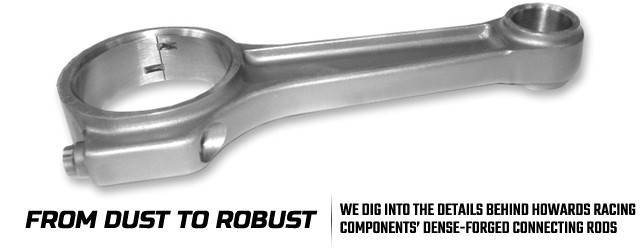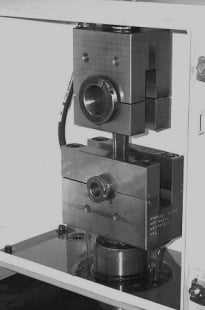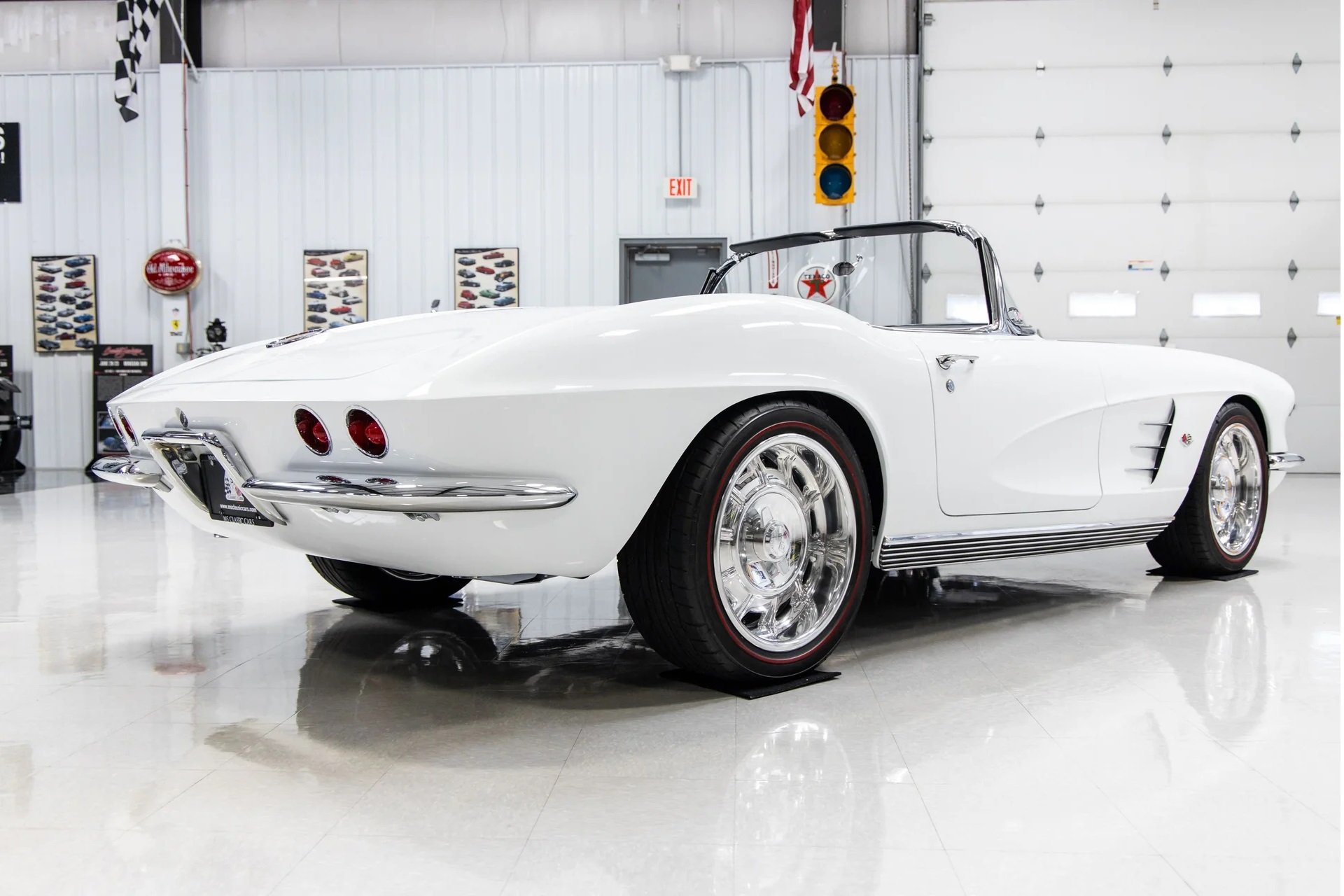When one thinks of powder, the first thing that might come to mind is the bottle of Johnson’s Baby Powder in the bathroom–not connecting rods in an engine. But over the last decade, powdered metals have become very prevalent in the engine industry, especially in the construction of connecting rods for both the performance and OE segments of the marketplace.
The sole company offering sinter-forged powdered metal connecting rods for the performance aftermarket is Howards Racing Components, based in Oshkosh, Wisconsin. The connecting rods are produced in partnership with GKN Sinter Metals; GKN is the world’s largest connecting rod manufacturer and heavily invested in building these same types of connecting rods for the OE manufacturers. Together, the companies have developed a product that is ideal for many performance builds, offering excellent durability, light weight, high strength, and a reasonable pricetag.
“Forged powder metal technology features an extremely dense grain structure when compared to a billet or conventional forging,” says HRC’s President, Steve Mugerauer. “It uses task-oriented steel materials that are too costly for high performance OEM connecting rods. Howards tailored the composition to excel in a racing environment when developing these products.”
One of the main materials used in the Howards connecting rods is ASTM 4260 steel, which rivals 300M steel’s strength, according to the company. The rest of the cocktail remains as mystery, as the specific makeup of the product is a closely-held competitive secret. The 4260 blend offers high tensile and yield strength with low elongation properties.
“We used CAD solids modeling for proof of concept and machined models from billet. We also use Finite Element Analysis to accurately simulate stress and reaction to stress, which allows for better strength and weight reduction in the correct places,” explains Mugerauer.
In the lab, the high-tech base powders and selected alloying elements are blended together, before the melting, atomizing, and annealing processes are controlled to create super fine powders that don’t have any impurities in them.
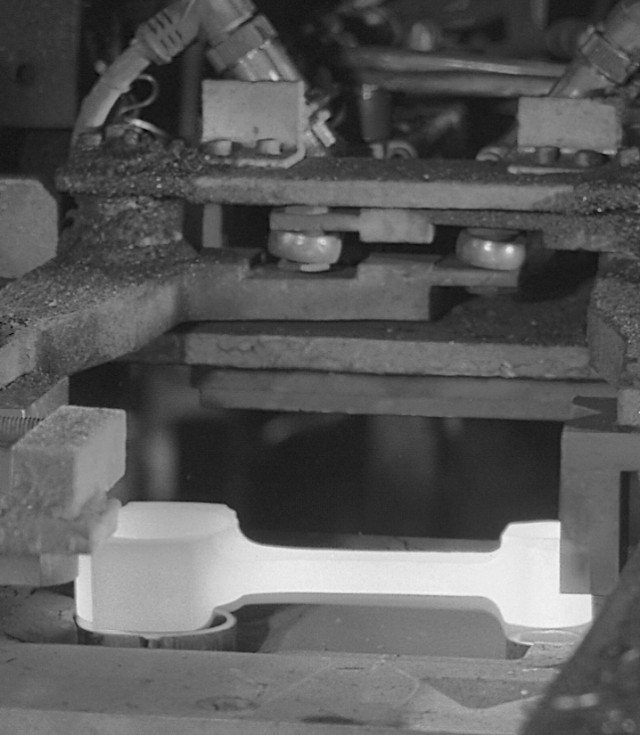
The hot-forging process uses a 750-ton press to ensure the material’s dense structure is finalized prior to the machining operations.
Following the materials mixing process, the base powder, lubricants, additives, and graphite elements are compacted under immense pressure, before the sintering (heating) process hits the newly-formed material with temperatures over 1500 degrees Fahrenheit to alter and refine the structure of the metal. Finally, the connecting rods are hot forged with a 750-ton press to finalize the structure of the material.
It sounds like they just throw a big pile of mixed-up powder together and heat it up, but that’s most certainly not the case.
The forged powder metal structure is unlike billet or traditional forged material in that it appears uniform when cut; no matter which direction the cut has been made, the material will look identical under a micron microscope.
“The metallurgy allows for superior material cleanliness and isotropic mechanical properties which allow the alloy materials to be more evenly distributed throughout the steel,” says Mugerauer.
One of the advantages to this material is the similar weight of each finished piece; they are all within 2 grams when finished. This means that should a connecting rod need replacement, it can be done with a single new piece; no rebalancing or other machining is required–just stick the new connecting rod into place and go. The I-beam geometry is engineered for ideal performance right out of the press.
“The reason the OE manufacturers abandoned traditional forged steel connecting rods for powder forged connecting rods is the ratio of durability and value to performance,” says Mugerauer. “We also use a proprietary cap fracturing process to fracture the rod cap from the body.”
Cap fracturing, for the uninitiated, is a process where the rod is made in one piece, then machinery is used to break the rod’s big end in two. Unlike traditional saw-cut connecting rods, using the fracturing process provides superior rod cap alignment since the surface of the cap will only align one way with the rod’s body, and also because no material is lost during the fracturing process. The fractured cap also eliminates fretting–undesirable cap movement–when the cap locks to the rod during the assembly process.
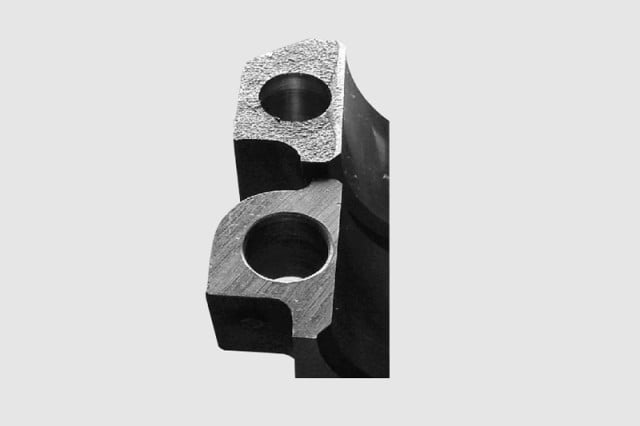
A fractured cap on top, versus a sawed-off cap on the bottom. It’s easy to see how the fractured cap locates itself more accurately during the assembly process.
The fracturing process also means that no alignment sleeves are necessary. The capscrews align the two pieces of the connecting rod perfectly, every time. Should the connecting rod need to be resized, it’s a simple process–the crank pin bore is honed out and oversize-OD bearings can be used.
AMPCO bushings are fitted to the small end of each rod, and 3/8-inch ARP2000 fasteners rather than the less-expensive 8740 pieces are used to secure the cap to the main body. The connecting rods offer light weights in the 585-gram range for 6.0-inch-long small-block Chevy connecting rods, while still retaining the ability to handle approximately 700 horsepower. That’s a stout number for a connecting rod that comes in with a street price around $500 for a set of eight.
Once the company has a design in mind, they create a preform that ensures proper material flow and “fill out” during the forging process. By controlling every aspect of the production process down to the material mixture, the company can ensure quality in every set of connecting rods.
Pieces are tested for endurance and tensile strength using race-worthy load simulations. They are also tested for fatigue failure and tested with a full load.
“We are not restricted by what 4340 billet plates or steel the mill produces on a given day,” says Mugerauer. “Even good American steel material varies in grain structure when it is rolled.”
The powder-forging process eliminates these concerns.



